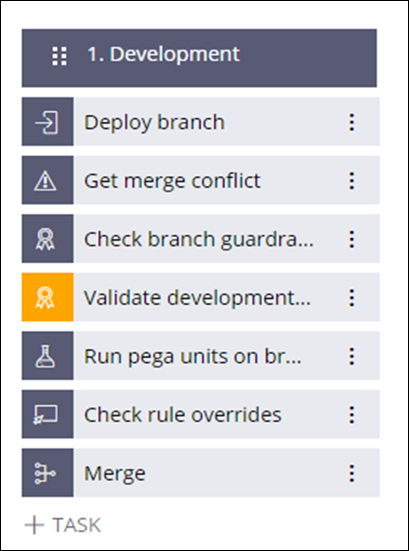Best practices for merge pipelines
During parallel application development, developers make changes and configurations that they need to frequently integrate with updates from other developers.
These changes need to meet the following requirements:
- Meet quality standards
- Be compatible with existing functionality
- Not conflict with a developer's application changes.
Use merge pipelines to merge branches into the base application. The system starts a merge only after validating branch changes against the quality gates, such as guardrails, branch reviews, and automated tests, which you configured on the pipeline. If the merge criteria are met, the system merges the branches. If any quality gates fail, the system rejects the merge request, and then notifies you about the failure.
The following figure shows the branch tasks that are available on the Development
environment for a merge pipeline. 
You can use the following tasks in a merge pipeline:
Tasks for a merge pipeline
| Task | Definition | Notes |
| Get merge conflict | Examines the rule conflicts for a specified branch of the base rule and reports an error if the branch rule conflicts with the base rule. | In the Conflicts and Warnings window in the Merge wizard, review and fix merge conflicts before you merge branches. For more information, see Conflicts and warnings in the Merge Branches wizard. |
| Check branch guardrail | Verifies that the guardrail weighted score meets a compliance score of 97%, which indicates a high performing application. The system calculates the weighted score by comparing guardrail warnings, weighted by severity and justification, against the total number of rules in the branch. Ensure that the score is 97% to continuously improve the quality of development. In addition to this check, validate that your development standards can enforce specific warnings and block the merge. | Monitor the number and severity of guardrail violations that the system found in your branch. By investigating and resolving the violations, you can improve your the overall quality of your branch. |
| Validate development standards | Validates if the rules in a branch meet the guardrail warnings that
you have specified in a policy. A default policy is available for users to use. This policy defines the high value guardrail warnings that must be enforced to reduce the risk of performance and security issues in Pega Platform or Pega application updates. This also helps you maintain an efficient, sustainable, and guardrail compliant application. For more information, see Managing development standards. | To assist you with using this task, you can:
|
| Run Pega units on branch | Validates your functionality by running Pega unit tests. The task can run Pega unit tests from a test application or from the application that is specified in the access group that the system supplies to the task. The task fails if the pass percentage is not 100%. | |
| Check rule overrides | Validates if the rules in the branch include overrides to final
rules. This task ensures that the system does not override any internal rules during branch merges, which helps control maintenance issues with new Pega Platform updates. Using this task results in an error if you override any Pega- provided rule that you cannot extend in the application. |
Previous topic Best practices for using pipelines in Deployment Manager Next topic Best practices for deployment pipelines
